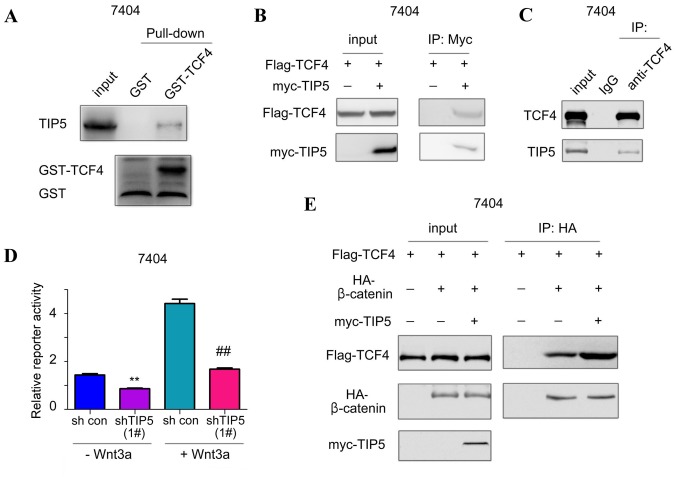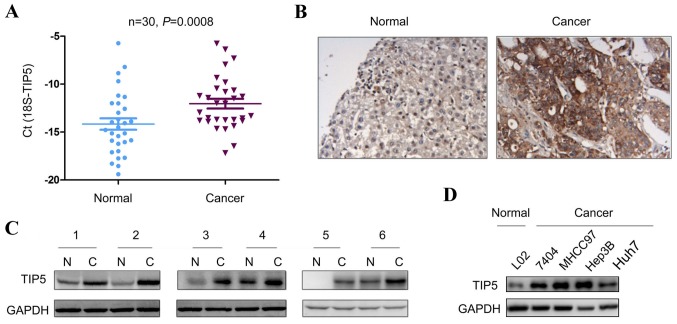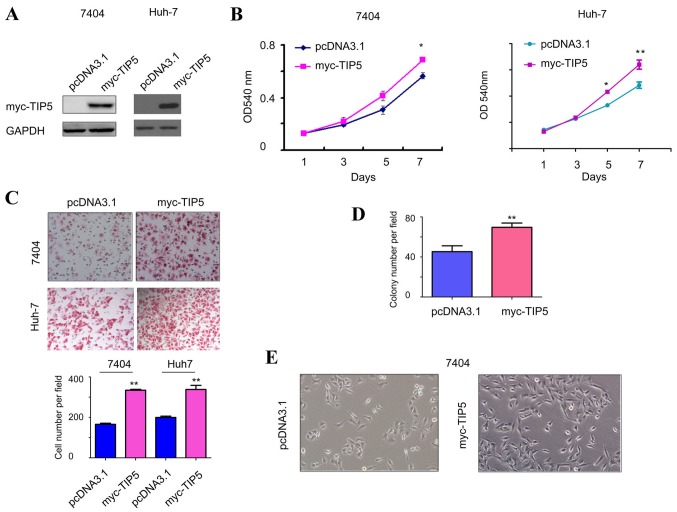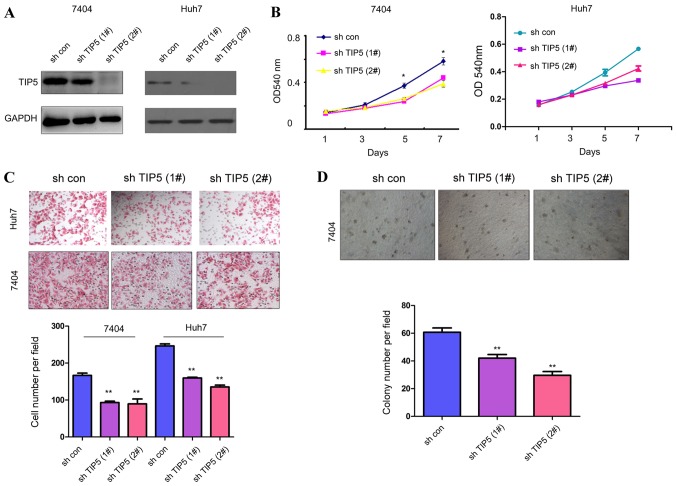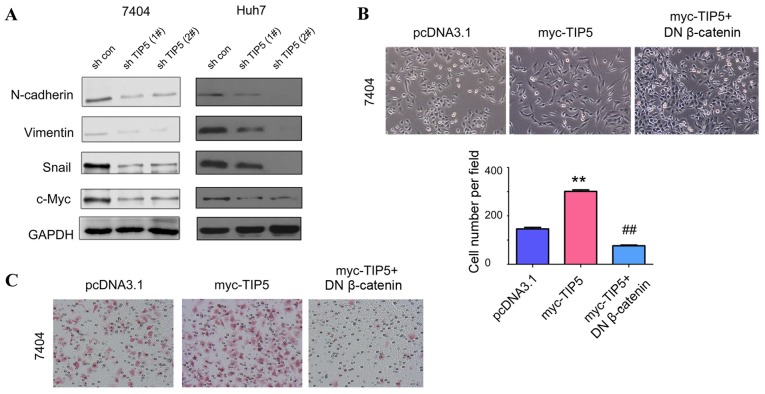Abstract
Aberrant activation of β-catenin/transcription factor 7 like 2 (TCF7L2) signaling is frequently observed during the progression of hepatocellular carcinoma (HCC). However, regulation of the nuclear β-catenin/TCF7L2 complex remains largely unknown. In the present study, immunoprecipitation and glutathione S-transferase pull-down assays identified transcription termination factor-1 interacting protein 5 (TIP5) as a binding partner of TCF7L2. TIP5 activated β-catenin/TCF7L2 signaling by enhancing the interaction between β-catenin and TCF7L2. The results from quantitative polymerase chain reaction and western blot analysis indicated that TIP5 was upregulated in clinical HCC samples. In addition, TIP5 positively regulated the proliferation of HCC cells in the MTT assay, colony formation in the soft agar assay, migration in the Boyden chamber assay and epithelial-mesenchymal transition of HCC cells by activating β-catenin/TCF7L2 signaling. Therefore, the results of the present study demonstrate that TIP5 serves an oncogenic role in HCC by activating β-catenin/TCF7L2 signaling, suggesting that TIP5 may be a promising therapeutic target for HCC.
Keywords: Transcription termination factor 1-interacting protein 5, β-catenin/transcription factor signaling, epithelial-mesenchymal transition, hepatocellular carcinoma
Introduction
Hepatocellular carcinoma (HCC) is one of the most common malignancies in the world (1). Although great progress has been made in the diagnosis of HCC, the outcome for HCC still remains very poor (1). Therefore, the identification of novel therapeutic targets in HCC is important.
The aberrant activation of Wnt/β-catenin signaling is frequently observed in hepatocellular carcinoma (HCC) (1,2). Previous studies have demonstrated that activation of Wnt/β-catenin signaling promotes the growth, migration, invasion and metastasis of HCC cells (3,4). Therefore, improving understanding of Wnt/β-catenin signaling regulation may improve treatment of HCC.
The expression of β-catenin, a key molecule involved in the Wnt/β-catenin signaling pathway, is tightly regulated in quiescent cells (5). Serine and threonine residues in the N-terminal of β-catenin are phosphorylated sequentially by cyclin-dependent kinase inhibitor and glycogen synthase kinase 3β, which leads to the degradation of β-catenin via the ubiquitin-proteasome system (5). The disassociation of the β-catenin destruction complex following the binding of Wnt ligands to the low-density lipoprotein receptor related protein 5/6 receptor causes the accumulation of β-catenin in the cytoplasm and the subsequent translocation of β-catenin to the nucleus. In the nucleus, β-catenin forms a complex with transcription factor 4 (TCF7L24) and regulates the expression of multiple genes, including c-Myc, cyclin D1 and Snail (6). Improved understanding of β-catenin/TCF7L2 complex regulation may help in the development of a novel therapeutic strategy to treat HCC.
Transcription termination factor (TTF)-1 interacting protein 5 (TIP5) is a component of the chromatin remodeling complex (7,8). Human TIP5 is a 211 kDa protein containing several protein and DNA interaction domains (8). Previous studies have revealed that TIP5 mediates the epigenetic regulation of recombinant RNA genes (9,10). The function of TIP5 in cancer is currently poorly understood. TIP5 is involved in epigenetic alterations in prostate cancer and its overexpression predicts disease recurrence (11). However, the role that TIP5 serves in the progression of HCC remains unknown.
In the present study, it was determined whether TIP5 was a binding partner of TCF7L2. In addition, the functions of TIP5 in the progression of HCC were investigated.
Materials and methods
Cell culture and patient samples
Normal human liver L02 and HCC 7404, MHCC97, Hep3B and Huh7 cell lines were obtained from the American Type Culture Collection (Manassas, VA, USA). Cells were cultured in Dulbecco's Modified Eagle medium (DMEM, Invitrogen; Thermo Fisher Scientific, Inc., Waltham, MA, USA) supplemented with 10% fetal bovine serum (Thermo Fisher Scientific, Inc.), penicillin (100 U/ml) and streptomycin (100 µg/ml). Cell cultures were maintained in a humidified incubator containing 5% CO2 at 37°C for passages 1–10. Patients with HCC (n=53; 23 females, 30 males; age, 47–72) between January 2015-December 2016 were enrolled in the present study. The collection of samples from patients was approved by the Institutional Ethics Committee of Cangnan People's Hospital (Wenzhou, China)and written informed consent was received from all patients in the present study. HCC samples were collected immediately following hepatectomy. The pathology was confirmed by the pathologist.
TIP5 knockdown in HCC cell lines
The lentivirus to knock down the expression of TIP5 in 7404 and Huh7 cells was purchased from GeneChem (Shanghai, China). Cells were incubated with the viral particles for 24 h (MOI=1) at 37°C and the green fluorescent protein (GFP)-positive cells were sorted by flow cytometry at 4°C and analyzed with WinMDI software (version 2.9; the Scripps Research Institute, La Jolla, CA, USA). The GFP was included in the purchased lentivirus. The following sequences were used: Small hairpin (sh) TIP5 1#, 5′-AAGAGTTCTGGGCCAACGG-3′; sh TIP5 2#, 5′-AAGAGCAGCCAGAACTGA-3′; and shcontrol (con), 5′-AAGATTTCGGGGGGCCCAA-3′. Experiments were subsequently performed one week post-transfection.
Reverse transcription-quantitative polymerase chain reaction (RT-qPCR)
Total RNA was extracted using TRIzol (Invitrogen; Thermo Fisher Scientific, Inc.) and cDNA was synthesized using the TaqMan microRNA reverse transcription kit (Bio-Rad Laboratories, Inc., Hercules, CA, USA) according to the manufacturer's instructions. qPCR was performed with SYBR-Green (Takara Biotechnology Co., Ltd., Dalian, China) in triplicates in a total volume of 8 µl (4 µl master mix and 4 µl cDNA) using a 7900 Real-Time PCR System (Applied Biosystems; Thermo Fisher Scientific, Inc.) with the following thermocycling conditions: 95°C for 30 sec, followed by 40 cycles of 95°C for 5 sec and 60°C for 30 sec. The relative expression of target genes was normalized to 18S (Applied Biosystems, Thermo Fisher Scientific, Inc.) and were calculated using the 2−ΔΔCq method (4). The primer sequences used were as follows: TIP5 forward, 5′-ACTGTATCTCACACTACTAC-3′ and reverse, 5′-GAAGGTTAGTGTTATGACTT-3′. 18S forward, 5′-GAGAAACGGCTACCACATCC-3′ and reverse, 5′-CACCAGACTTGCCCTCCA-3′.
Protein extraction and western blot analysis
HCC cells (normal human liver cell line L02 and HCC cell lines 7404, MHCC97, Hep3B and Huh7) were collected and incubated in radioimmunoprecipitation assaylys is buffer (Thermo Fisher Scientific, Inc.) containing protease inhibitor (Sigma-Aldrich; Merck KGaA, Darmstadt, Germany) for 30 min for protein extraction. Subsequently, cell lysates were centrifuged at 120,000 × g for 20 min at 4°C. The concentration of the protein was determined using Bradford reagent. Protein (10 µg/lane) was loaded and subjected to 10% SDS-PAGE, and were transferred to a polyvinylidene fluoride membrane. Samples were blocked in 5% non-fat milk with 1X Tris-buffered saline with Tween-20 for 1 h. Subsequently, membranes were incubated with primary antibodies against TIP5 (cat. no. 195278; Abcam, Cambridge, UK; 1:1,000 dilution), Snail (cat. no. 3879; CST Biological Reagents Co., Ltd., Shanghai, China; 1:1,000 dilution), vimentin (cat. no. 5741; CST Biological Reagents Co., Ltd.; 1:1,000 dilution), N-cadherin (cat. no. 13116; CST Biological Reagents Co., Ltd.; 1:1,000 dilution), c-Myc (cat. no. 13987; CST Biological Reagents Co., Ltd.; 1:1,000 dilution) and GAPDH antibody (cat. no. 5174; CST Biological Reagents Co., Ltd.; 1:5,000 dilution) overnight at 4°C. Secondary anti-rabbit antibody conjugated with peroxidase (cat. no. 7074; CST Biological Reagents Co., Ltd.; 1:1,000 dilution) was applied to membranes for 1 h at room temperature. Following immunoblotting, bands were visualized using an enhanced chemiluminescent kit (Thermo Fisher Scientific, Inc.).
MTT assay
Huh7 and 7404 cells were counted with a hemocytometerand placed in 96-well plates (1,000 cells/well) in triplicate and incubated with fresh DMEM medium (containing 10% FBS) at 37°C for 0, 1, 3, 5 or 7 days. MTT (Dojindo Molecular Technologies Inc. Rockville, MD, USA) Cells were incubated with MTT (200 µl/ml medium) for 4 h and subsequently cultured for 0, 1, 3, 5 and 7 days to assess cell proliferation. Cell proliferation curves were determined once absorbance at 540 nm was measured using a microplate reader.
Plasmid construction and cell transfection
The TIP5 sequence was amplified from the cDNA of HCC tissues and generated using PCR with KOD DNA polymerase (Takara Biotechnology Co., Ltd.) and the following thermocycling conditions: 95°C for 30 sec, followed by 40 cycles of 95°C for 5 sec, 60°C for 30 sec and 68°C for 90 sec. TIP5 was subsequently subcloned into the pcDNA3.1 vector (Takara Biotechnology Co., Ltd.). The forward primer sequence for TIP5 is 5′-ATGGAGGCAAACGACCATTTT-3′; the reverse primer sequence was 5′-TCACAAGATTGGCCTGTTTTCC-3′. TIP5 (0.5 µg) or dominant negative (DN) β-catenin plasmids (0.5 µg; provided by Dr Michael Levin; Rockefeller University, New York, NY, USA) were transfected into 7404 or Huh7 cells using Lipofectamine® 2000 reagent (Invitrogen; Thermo Fisher Scientific, Inc.) according to the manufacturer's instructions. Following 48 h culture, transfected cells were selected with G418. After 2 weeks, G418-resistant cells were pooled and the expression of myc-TIP5 was verified using anti-Myc antibody (1:1,000, cat. no. sc-4084; Santa Cruz Biotechnology, Inc., Dallas, TX, USA) in western blot analysis (overnight at 4°C).
Cell migration assays
Cells (7404 and Huh7) were seeded on the top layer of the Boyden chamber with 50 µl DMEM supplemented with 1% FBS. 152 µl DMEM supplemented with 10% FBS was used as a chemoattractant in the bottom chamber. Cells (1×105) were incubated at 37°C for 12 h. Non-migratory cells in the top chambers were removed with cotton swabs. The migrated cells in the lower membrane surface were fixed in 100% methanol for 5 min, air-dried, stained with eosin for 5 min and then counted under a light microscope (magnification, ×10). Cell morphology alterations were assessed under the microscope.
Immunohistochemistry
Tissues were fixed with 4% paraformaldehyde overnight at 4°C. Xylene and ethanol was used to deparaffinize and rehydrate the 5 µm paraffin-embedded HCC tissue. Endogenous peroxidase activity was blocked with 0.35% H2O2 solution. Antigen retrieval was performed at 100°C using a microwave and tissues were subsequently washed with PBS. Non-specific binding was blocked using 1% bovine serum albumin (Sangon Biotech Co., Ltd., Shanghai, China)solution at room temperature for 1 h. Sections were stained with TIP5 antibody (1:100) at 4°C overnight and incubated with secondary antibody at room temperature for 1 h (DAKO; Agilent Technologies, Inc., Santa Clara, CA, USA). Slides were subsequently developed with 3,3′-diaminobenzidine at room temperature for 3 min and counterstained with hematoxylin. The slides were examined under a light microscope (magnification, ×10).
Glutathione S-transferase (GST) pull-down assay
The GST pull-down was performed as previously described (5). The coding sequence of TCF7L2 from 7404 cells was cloned into the vector pGEX-4T-1 to obtain the GST tag. The GST fusion protein was purified by sepharose 4B beads, according to the manufacturer's instructions (GE Healthcare Life Sciences, Shanghai, China) (5). Cells (7404) were grown to 80% confluence and were harvested with lysis buffer (50 mM Tris-HCl, 0.5% Triton X-100) and centrifuged (12,000 × g at 4°C) for 10 min. Cell lysates were incubated with 5 µg GST or GST-TCF7L24 protein overnight at 4°C. Subsequently, Sepharose 4B beads (GE Healthcare Life Sciences) were added to capture the GST fusion protein. The pulled down protein (1 µg/well) was separated using 10% SDS-PAGE and western blot was performed.
Immunoprecipitation
Cells (7404) were cultured until 70% confluence was reached and were harvested with lysis buffer, and centrifuged (12,000 × g) at 4°C for 20 min. The supernatant (500 µl) of cell lysate was incubated with the following primary antibodies: Anti-myc (1:1,000), anti-hemagglutin in tag (cat. no. H9658; Sigma-Aldrich; Merck KGaA, 1:5,000 dilution) and anti-TCF4 (cat. no. 2569; CST Biological Reagents Co., Ltd; 1:500 dilution) and incubated overnight at 4°C. Subsequently, protein A beads were added to the cell supernatant and incubated for a further 4 h at 4°C. Beads were washed with lysis buffer three times and the immuneprecipitated proteins (1 µg/well) were eluted with loading buffer (CST Biological Reagents Co., Ltd.; 1:1,000 dilution) and separated by 10% SDS-PAGE. The bands were visualized with an enhanced chemiluminescence kit (Thermo Fisher Scientific, Inc.).
Mass spectrometry
Mass spectrometry was performed by the commercial services of the Institute of Biophysics, Chinese Academy of Science (Beijing, China).
Topflash reporter assay
Cells (7404) were grown to 80% confluence and reporter assays were performed using 0.1 µg Topflash (Takara Biotechnology Co., Ltd.), 0.5 µg TIP5 shRNA vector (pLKO.1) and 0.05 µg TK Renilla luciferase. The reporter was constructed using the tandem repeats of the TCF binding elements, as described previously (12). The plasmids were transfected using Lipofectamine® 2000. After 48 h, cells were treated with Wnt3a (100 ng/ml) protein for 8 h. Cell lysates were prepared and reporter activity was measured using the dual-luciferase reporter assay system (Promega Corp., Madison, MA, USA) and normalized to Renilla luciferase activity to confirm transfection efficiency.
Soft agar assay
Control and TIP5 shRNA cells (7404; 1×104 cells/well) were seeded in 1 ml 0.5% noble agar in complete DMEM medium overlaying 2 ml 1% agar in the same medium. Following 2 weeks culture at 37°C, cell colonies were examined under a light microscope (magnification, ×10).
Statistical analysis
Results were expressed as the mean ± standard deviation as indicated. Differences between values were statistically analyzed by SPSS (version 15.0; SPSS, Inc., Chicago, IL, USA) using a Student's t-test or one-way analysis of variance followed by Dunnett's test for multiple comparisons. P<0.05 was considered to indicate a statistically significant difference.
Results
TIP5 interacts with TCF7L24 in HCC cell lines
To screen novel regulators for β-catenin/TCF7L2 signaling, 7404 cell lysate was immunoprecipitated with anti-TCF7L24 antibody and the TCF7L24-binding protein was identified using mass spectrometry (data not shown). TIP5, a nuclear transcriptional activator, was identified to be a potential candidate for TCF7L24 binding. To further investigate the interaction between TCF7L24 and TIP5, a GST pull-down assay was performed. The fusion protein GST-TCF7L24 was purified and incubated with the 7404 cell lysates. As indicated in Fig. 1A, the endogenous TIP5 in 7404 cells was pulled down by the GST-TCF7L24 fusion protein, suggesting an interaction occurred between TCF7L24 and TIP5. In addition, the ectopically expressed TIP5 (myc-TIP5) and TCF7L24 (Flag-TCF7L24) formed a complex in 7404 cells (Fig 1B). Furthermore, endogenous TIP5 and TCF7L24 bound to each other in the immunoprecipitation assay (Fig. 1C). These data suggest that TIP5 and TCF7L24 interact within 7404 HCC cells. The effects of TIP5 on the activity of β-catenin/TCF7L2 signaling were assessed using a Topflash reporter assay. It was indicated that TIP5 knockdown significantly impaired the Topflash reporter activity both at the basal level and following the treatment with Wnt3a (Fig. 1D). Consistent with these observations, overexpression of TIP5 enhanced the interaction between β-catenin and TCF7L24 (Fig. 1E). Taken together, these data suggest that TIP5 interacts with TCF7L24 and activates β-catenin/TCF7L2 signaling.
Figure 1.
TIP5 interacts with TCF7L24. (A) A GST pull-down assay was performed to examine the interaction between GST-TCF7L24 fusion protein and endogenously expressed TIP5 in 7404 cells. (B) An immunoprecipitation assay was performed to examine the interaction between exogenously expressed TIP5 (myc-TIP5) and TCF7L24 (Flag-TCF7L24) in 7404 cells. (C) An immunoprecipitation assay was performed to examine the interaction between endogenously expressed TIP5 and TCF7L24 in 7404 cells. (D) A topflash reporter assay was performed in 7404 cells. (E) An immunoprecipitation assay was performed to examine the effects of TIP5 on the interaction between exogenously expressed β-catenin (HA-β-catenin) and TCF7L24 (Flag-TCF7L24) in 7404 cells. Data are presented as the mean ± standard deviation. sh, small hairpin; GST, glutathione S-transferase; TCF7L24, Transcription factor 4; TIP5, transcription termination factor-1 interacting protein 5; con, control; IP, immunoprecipitation; HA, hemagglutinin tag; input, cell lysate. ##P<0.01, **P<0.01 vs. the respective sh con group.
TIP5 is upregulated in HCC
The expression pattern of TIP5 was assessed in HCC. The mRNA expression of TIP5 in 30 HCC tissues and paired non-cancerous tissues was examined using RT-qPCR. TIP5 mRNA expression was significantly elevated in HCC tissues (Fig. 2A). Immunohistochemistry and western blot analysis demonstrated that the expression of TIP5 protein was increased in HCC tissues (Fig. 2B and C). In addition, the protein expression of TIP5 in a panel of HCC cell lines was examined. The increased expression of TIP5 was identified in a number of HCC cell lines compared with L02 normal liver cells (Fig. 2D). Collectively, these results indicate that TIP5 is upregulated in HCC.
Figure 2.
TIP5 is upregulated in HCC. (A) mRNA and (B) protein expression of TIP5 in HCC and paired non-cancerous tissues was examined using reverse transcription-quantitative polymerase chain reaction and immunohistochemistry, respectively. Blue indicates nuclear staining and brown indicates TIP5 expression. (C) The expression of TIP5 protein in HCC tissue and paired non-cancerous tissues was examined using western blot analysis. (D) Expression of TIP5 protein in HCC cell lines compared with L02 normal liver cells, as determined by western blot analysis. N, non-cancerous; C, cancerous; HCC, hepatocellular carcinoma; TCF7L24, transcription factor 4; TIP5, transcription termination factor-1 interacting protein 5.
To study the functions of TIP5 in the progression of HCC, the expression of TIP5 in 7404 and Huh7 cells was investigated following the promotion of TIP5 expression (Fig 3A). Furthermore, the role of TIP5 in the proliferation, migration and colony formation of HCC cells was evaluated. The results indicated that induced expression of TIP5 significantly promoted the proliferation, migration and colony formation of 7404 and Huh7 cells (Fig. 3B-D). Notably, upregulating the expression of TIP5 induced a morphological change in 7404 cells, from an epithelial to shuttle shape. This suggests that TIP5 may have induced the epithelial-mesenchymal transition (EMT) in 7404 cells (Fig. 3E). In accordance with these results, TIP5 knockdown in 7404 and Huh7 cells significantly inhibited the proliferation, migration and colony formation of HCC cells (Fig. 4). In summary, these data suggest that TIP5 promotes HCC progression.
Figure 3.
TIP5 promotes the proliferation and migration of HCC cells. (A) The overexpression of TIP5 (myc-TIP5) in 7404 and Huh7 cells was identified. (B) An MTT assay was performed to examine the effects of TIP5 on the proliferation of HCC cells. (C) A Boyden chamber assay was performed to examine the effects of TIP5 on the migration of HCC cells. Magnification, ×10. (D) A soft agar assay was performed to examine the effects of TIP5 on the anchorage-independent growth of HCC cells. (E) TIP5 induced a morphological change in 7404 cells. Data are presented as the mean ± standard deviation. Magnification, ×10. *P<0.05, **P<0.01 vs. pcDNA3.1. HCC, hepatocellular carcinoma; TIP5, transcription termination factor-1 interacting protein 5; OD, optical density.
Figure 4.
TIP5 knockdown inhibits the growth and migration of HCC cells. (A) The effects of TIP5 knockdown in 7404 and Huh7 cells was assessed using western blot analysis. (B) An MTT assay was performed to examine the effects of TIP5 knockdown on the growth of HCC cells. *P<0.05 vs. sh TIP5 (1#) or (2#). Data were presented as the mean ± standard deviation. (C) A Boyden chamber assay was performed to examine the effects of TIP5 knockdown on the migration of HCC cells. Magnification, ×10. (D) A soft agar assay was performed to examine the effects of TIP5 knockdown on the anchorage-independent growth of HCC cells. Magnification, ×10. Data are presented as the mean ± standard deviation. *P<0.05, **P<0.01 vs. sh con. HCC, hepatocellular carcinoma; TIP5, transcription termination factor-1 interacting protein 5; sh, small hairpin; con, control; OD, optical density.
TIP5 promotes the EMT by activating β-catenin/TCF7L2 signaling
The morphological changes in 7404 cells induced by TIP5 overexpression indicate that TIP5 may promote the EMT in HCC cells. As indicated in Fig. 5A, TIP5 knockdown downregulated the expression of N-cadherin and vimentin, two markers of mesenchymal cells (12). In addition, TIP5 knockdown inhibited the expression of c-Myc and Snail, two regulators of the EMT (13). To examine whether TIP5 promotes the EMT by activating β-catenin/TCF7L2 signaling, a DN β-catenin, a negative regulator for beta-catenin/TCF7L2 signaling, was used to rescue the phenotypes of TIP5, as described previously (6) As indicated in Fig. 5B and C, DN β-catenin significantly reversed the changes in 7404 cell morphology and migration induced by TIP5. Taken together, these results demonstrate that TIP5 promotes the EMT by activating β-catenin/TCF7L2 signaling.
Figure 5.
TIP5 promotes the migration of HCC cells by activating β-catenin/transcription factor signaling. (A) TIP5 knockdown inhibited the expression of proteins associated with the epithelial-mesenchymal transition. (B) DN β-catenin reversed the morphological changes induced by TIP5. Magnification, ×10. (C) DN β-catenin rescued the migration of HCC cells. Data are presented as the mean ± standard deviation. Magnification, ×10. **P<0.01 vs. pcDNA3.1, ##P<0.01 vs. myc-TIP5. HCC, hepatocellular carcinoma; TIP5, transcription termination factor-1 interacting protein 5; DN, dominant negative; sh, small hairpin; con, control.
Discussion
HCC is one of the most common malignancies in the world (14). Numerous studies have identified that β-catenin/TCF7L2 signaling serves an oncogenic role in the progression of HCC and have indicated that targeting β-catenin/TCF7L2 signaling may be a promising therapeutic strategy (15–17). The present study demonstrated that TIP5 was upregulated in HCC tissues and promoted the proliferation, colony formation, migration and EMT of HCC cells. Furthermore, TIP5 interacted with TCF7L24 to activate β-catenin/TCF7L2 signaling. These data suggest that TIP5 promotes the progression of HCC and may be a potential therapeutic target.
Notably, the present study identified an interaction between TCF7L24 and TIP5, a chromatin remodeling factor. It was demonstrated that TIP5 strengthened the interaction between β-catenin and TCF7L24. Several factors regulate the interaction between β-catenin and TCF7L24. For example, it has been indicated that catenin ß interacting protein 1 (ICAT) weakens the interaction between β-catenin and TCF7L24 (18). As a result, it is possible that TIP5 and ICAT compete to regulate the interaction between β-catenin and TCF7L24. Furthermore, TCF7L24 has DNA-binding capabilities and the interaction that occurs between TCF7L24 and TIP5 suggests that TCF7L24 may be involved in epigenetic regulation.
The results of the present study suggest that the overexpression of TIP5 promotes cell migration and the EMT in 7404 cells. The expressionof TIP5 in the non-invasive L02 normal liver cells was lower compared with in invasive HCC cell lines. These observations suggest that there is an association between TIP5 and cell motility. Notably, TIP5 induced a morphological change in 7404 cells and TIP5 knockdown inhibited the expression of the mesenchymal markers N-cadherin and vimentin, as well as the expression of the EMT regulator Snail. Furthermore, TIP5 promoted the migration of HCC cells, which was consistent with the results of a previous study demonstrating that TIP5 overexpression predicted prostate cancer recurrence (11). In addition, the promoting effects of TIP5 on HCC cell migration was blocked by the expression of DN β-catenin, further supporting the factthat TIP5 promotes the migration of HCC cells by activating β-catenin/TCF7L2 signaling.
In the present study, TIP5 promoted the growth of HCC cells in liquid culture and in soft agar, suggesting that TIP5 enhanced the tumorigenicity of HCC cells. Activation of β-catenin/TCF7L2 signaling by TIP5 may explain why it promotes effects cell colony formation.
In conclusion, the results of the present study demonstrated that TIP5 regulates β-catenin/TCF7L2 signaling via TIP5 during HCC progression and suggests that TIP5 may be a promising therapeutic target for the treatment of HCC.
Acknowledgements
Not applicable.
Funding
No funding was received.
Availability of data and materials
The analyzed datasets generated during the study are available from the corresponding author on reasonable request.
Authors' contributions
KX and CL designed this study. CL and WW performed the cell assays. HD and QL performed the molecular mechanism experiments.
Ethics approval and consent to participate
The collection of samples from patients was approved by the Institutional Ethics Committee of Cangnan People's Hospital (Wenzhou, China) and written informed consent was received from all patients in the present study.
Consent for publication
Not applicable.
Competing interests
The authors declare that they have no competing interests.
References
- 1.Wang W, Pan Q, Fuhler GM, Smits R, Peppelenbosch MP. Action and function of Wnt/β-catenin signaling in the progression from chronic hepatitis C to hepatocellular carcinoma. J Gastroenterol. 2017;52:419–431. doi: 10.1007/s00535-016-1299-5. [DOI] [PMC free article] [PubMed] [Google Scholar]
- 2.Tao J, Zhang R, Singh S, Poddar M, Xu E, Oertel M, Chen X, Ganesh S, Abrams M, Monga SP. Targeting β-catenin in hepatocellular cancers induced by coexpression of mutant β-catenin and K-Ras in mice. Hepatology. 2017;65:1581–1599. doi: 10.1002/hep.28975. [DOI] [PMC free article] [PubMed] [Google Scholar]
- 3.Peng YY, He YH, Chen C, Xu T, Li L, Ni MM, Meng XM, Huang C, Li J. NLRC5 regulates cell proliferation, migration and invasion in hepatocellular carcinoma by targeting the Wnt/β-catenin signaling pathway. Cancer Lett. 2016;376:10–21. doi: 10.1016/j.canlet.2016.03.006. [DOI] [PubMed] [Google Scholar]
- 4.Qu C, He, Lu X, Dong L, Zhu Y, Zhao Q, Jiang X, Chang P, Jiang X, Wang L, et al. Salt-inducible Kinase (SIK1) regulates HCC progression and WNT/β-catenin activation. J Hepatol. 2016;64:1076–1089. doi: 10.1016/j.jhep.2016.01.005. [DOI] [PubMed] [Google Scholar]
- 5.Polakis P. More than one way to skin a catenin. Cell. 2001;105:563–566. doi: 10.1016/S0092-8674(01)00379-8. [DOI] [PubMed] [Google Scholar]
- 6.Suda T, Arai F. Wnt signaling in the niche. Cell. 2008;132:729–730. doi: 10.1016/j.cell.2008.02.017. [DOI] [PubMed] [Google Scholar]
- 7.Nardocci G, Simonet NG, Navarro C, Langst G, Alvarez M. Differential enrichment of TTF-I and Tip5 in the T-like promoter structures of the rDNA contribute to the epigenetic response of Cyprinus carpio during environmental adaptation. Biochem Cell Biol. 2016;94:315–321. doi: 10.1139/bcb-2016-0015. [DOI] [PubMed] [Google Scholar]
- 8.Tallant C, Valentini E, Fedorov O, Overvoorde L, Ferguson FM, Filippakopoulos P, Svergun DI, Knapp S, Ciulli A. Molecular basis of histone tail recognition by human TIP5 PHD finger and bromodomain of the chromatin remodeling complex NoRC. Structure. 2015;23:80–92. doi: 10.1016/j.str.2014.10.017. [DOI] [PMC free article] [PubMed] [Google Scholar]
- 9.Anosova I, Melnik S, Tripsianes K, Kateb F, Grummt I, Sattler M. A novel RNA binding surface of the TAM domain of TIP5/BAZ2A mediates epigenetic regulation of rRNA genes. Nucleic Acids Res. 2015;43:5208–5220. doi: 10.1093/nar/gkv365. [DOI] [PMC free article] [PubMed] [Google Scholar]
- 10.Cong R, Das S, Ugrinova I, Kumar S, Mongelard F, Wong J, Bouvet P. Interaction of nucleolin with ribosomal RNA genes and its role in RNA polymerase I transcription. Nucleic Acids Res. 2012;40:9441–9454. doi: 10.1093/nar/gks720. [DOI] [PMC free article] [PubMed] [Google Scholar]
- 11.Gu L, Frommel SC, Oakes CC, Simon R, Grupp K, Gerig CY, Bär D, Robinson MD, Baer C, Weiss M, et al. BAZ2A (TIP5) is involved in epigenetic alterations in prostate cancer and its overexpression predicts disease recurrence. Nat Genet. 2015;47:22–30. doi: 10.1038/ng.3165. [DOI] [PubMed] [Google Scholar]
- 12.Fu L, Liu M, Yu X, Li X. Expressions of epithelial cell adhesion molecule, vimentin and N-cadherin in molecular subtypes of breast cancer and the correlation among them. Zhong Nan Da Xue Xue Bao Yi Xue Ban. 2016;41:1137–1142. doi: 10.11817/j.issn.1672-7347.2016.11.004. (In Chinese) [DOI] [PubMed] [Google Scholar]
- 13.Furuya S, Endo K, Takahashi A, Miyazawa K, Saitoh M. Snail suppresses cellular senescence and promotes fibroblast-led cancer cell invasion. FEBS Open Bio. 2017;7:1586–1597. doi: 10.1002/2211-5463.12300. [DOI] [PMC free article] [PubMed] [Google Scholar]
- 14.Siegel RL, Miller KD, Jemal A. Cancer Statistics, 2017. CA Cancer J Clin. 2017;67:7–30. doi: 10.3322/caac.21387. [DOI] [PubMed] [Google Scholar]
- 15.Iguchi T, Yamagata M, Sonoda T, Yanagita K, Fukahori T, Tsujita E, Aishima S, Oda Y, Maehara Y. Malignant transformation of hepatocellular adenoma with bone marrow metaplasia arising in glycogen storage disease type I: A case report. Mol Clin Oncol. 2016;5:599–603. doi: 10.3892/mco.2016.1034. [DOI] [PMC free article] [PubMed] [Google Scholar]
- 16.Zhang JJ, Chen JT, Hua L, Yao KH, Wang CY. miR-98 inhibits hepatocellular carcinoma cell proliferation via targeting EZH2 and suppressing Wnt/β-catenin signaling pathway. Biomed Pharmacother. 2017;85:472–478. doi: 10.1016/j.biopha.2016.11.053. [DOI] [PubMed] [Google Scholar]
- 17.Fan X, Ma X, Cui L, Dang S, Qu J, Zhang J, Wang X, Mao Z. CARF activates beta-catenin/TCF signaling in the hepatocellular carcinoma. Oncotarget. 2016;7:80404–80414. doi: 10.18632/oncotarget.13138. [DOI] [PMC free article] [PubMed] [Google Scholar]
- 18.Tago K, Nakamura T, Nishita M, Hyodo J, Nagai S, Murata Y, Adachi S, Ohwada S, Morishita Y, Shibuya H, et al. Inhibition of Wnt signaling by ICAT, a novel β-catenin-interacting protein. Genes Dev. 2000;14:1741–1749. [PMC free article] [PubMed] [Google Scholar]
Associated Data
This section collects any data citations, data availability statements, or supplementary materials included in this article.
Data Availability Statement
The analyzed datasets generated during the study are available from the corresponding author on reasonable request.



